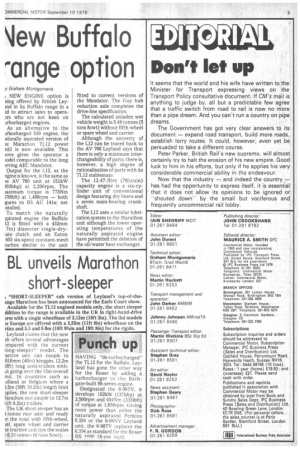qew Buffalo mange option
Page 7

If you've noticed an error in this article please click here to report it so we can fix it.
y Graham Montgomerie
NEW ENGINE option is eing offered by British LeyInd in its Buffalo range in a Id to attract sales to opera)rs who are not keen on irbocharged engines.
As an alternative to the obocharged 510 engine, the aturally aspirated version of ie Marathon TL12 power ntil is now available. This kove gives the operator a *del comparable to the long ?.rving AEC Mandator.
Output for the L12, as the agine is known, is the same as le AV 760 unit at 151kW l03bhp) at 2,200rpm. The iaximum torque is 773Nm i701bft) at 1,400rpm — both gures to BS AU 141a: net istalled.
To match the naturally 3pirated engine the Buffalo 12 is fitted with a 432mm 7in) diameter single-dry[ate clutch and an Eaton 403 six-speed constant-mesh ,arbox similar to the unit fitted to current versions of the Mandator. The Guy hub reduction axle completes the drive-line specification.
The calculated unladen wet vehicle weight is 5.48 tonnes (5 tons 8cwt) without fifth-wheel or spare wheel and carrier.
Although the ancestry of the L12 can be traced back to the AV 760 Leyland says that there is only a minimum interchangeability of parts; there is, however, a high degree of rationalisation of parts with its TL12 stablemate.
The 12.47-litre (761cuin) capacity engine is a six-cylinder unit of conventional design featuring dry liners and a seven main-bearing crankshaft.
The L12 uses a similar lubrication system to the Marathon unit although the lower operating temperatures of the naturally aspirated engine have permitted the deletion of the oil/water heat exchanger.




























































































